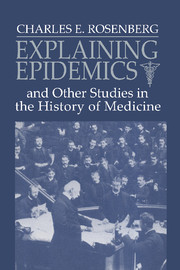Book contents
- Frontmatter
- Contents
- Acknowledgments
- Introduction: Why care about the history of medicine?
- I Ideas as actors
- 1 The therapeutic revolution: Medicine, meaning, and social change in nineteenth-century America
- 2 Medical text and social context: Explaining William Buchan's Domestic Medicine
- 3 John Gunn: Everyman's physician
- 4 Body and mind in nineteenth-century medicine: Some clinical origins of the neurosis construct
- 5 Florence Nightingale on contagion: The hospital as moral universe
- 6 Cholera in nineteenth-century Europe: A tool for social and economic analysis
- II Institutions and medical care
- III The past in the present: Using medical history
- Index
2 - Medical text and social context: Explaining William Buchan's Domestic Medicine
Published online by Cambridge University Press: 29 March 2010
- Frontmatter
- Contents
- Acknowledgments
- Introduction: Why care about the history of medicine?
- I Ideas as actors
- 1 The therapeutic revolution: Medicine, meaning, and social change in nineteenth-century America
- 2 Medical text and social context: Explaining William Buchan's Domestic Medicine
- 3 John Gunn: Everyman's physician
- 4 Body and mind in nineteenth-century medicine: Some clinical origins of the neurosis construct
- 5 Florence Nightingale on contagion: The hospital as moral universe
- 6 Cholera in nineteenth-century Europe: A tool for social and economic analysis
- II Institutions and medical care
- III The past in the present: Using medical history
- Index
Summary
One can make a strong case for William Buchan's Domestic Medicine being the most widely read – nonreligious – book in English during the half century following its Edinburgh publication in 1769. Certainly it was the most frequently reprinted medical treatise in Britain and the United States. Its pages illustrate with particular clarity the shared knowledge and assumptions that bound professionals and lay people together in a community of ideas and healing practice. Buchan concedes the reality of lay practice and the widespread distribution of medical knowledge, yet seeks to define a special role for the credentialed physician.
I had long felt a bookshop browser's interest in Buchan's treatise; it was the only pre-1850 medical text that one was almost certain to find in the “old medical” section of any used or rare bookshop. But when I began my academic work in the early 1960s, it had not seemed an appropriately dignified subject for research. After writing the previous chapter on traditional therapeutics in the mid-1970s, however, I began to think more systematically about the day-to-day aspects of Anglo-American medical care and Buchan seemed an obvious place to start. A growing interest among professional historians in popular ideas and world-views also made the Edinburgh physician's effort to improve “domestic medicine” a potential tool for use in evaluating the relationships among high, low, and middle orders. Material that had seemed marginal – quaint and anecdotal – when I began graduate school in the late 1950s had gradually become acceptable, even exciting to a growing number of professional historians.
- Type
- Chapter
- Information
- Explaining Epidemics , pp. 32 - 56Publisher: Cambridge University PressPrint publication year: 1992
- 1
- Cited by



